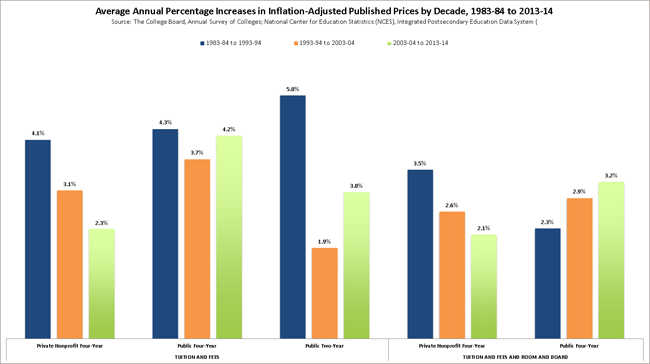Title: Hikes in Tuition and Cuts to Pell Grants
Data released today by The College Board’s Trends in Higher Education series, Education Pays 2013, Trends in Student Aid and Trends in College Pricing, reported that in spite of increases in college costs and decreases in financial support, investment in higher education pays-off in the long run.
Tuition is on the Rise. Each year colleges raise their tuition and fees, affecting the finances of many students and their families across the nation. Despite the increases in tuition and fees, 2013-2014 was a promising year with only a 2.9 percent increase for in-state public four-year institutions, the smallest year-to-year percent increase in over 30-years. Private non-profit four-year institutions increased by 3.8 percent, only slightly lower the than previous year.
Federal Grants are diminishing. Financial support from federal grants is failing to compensate for the increase in tuition prices. In previous years as prices increased, many students benefited from comparable increases in federal grant aid and government tax benefits. However, between 2010-11 and 2012-13, federal grants have declined requiring students to actually pay more for their college.
Education Pays
 Education Pays 2013: The Benefits of Higher Education for Individuals and Society documents the ways in which both individuals and society as a whole benefit from increased levels of education. The report examines differences in the earnings and employment patterns of U.S. adults with different levels of education. It compares health-related behaviors, reliance on public assistance programs, civic participation, and indicators of the well-being of the next generation. Financial benefits are easier to document than nonpecuniary benefits, but the latter may be as important to students themselves, as well as to the society in which they participate. In addition to the financial and nonpecuniary benefits of higher education, Education Pays 2013examines the increases and the persistent disparities across demographic groups in college participation and completion.
Education Pays 2013: The Benefits of Higher Education for Individuals and Society documents the ways in which both individuals and society as a whole benefit from increased levels of education. The report examines differences in the earnings and employment patterns of U.S. adults with different levels of education. It compares health-related behaviors, reliance on public assistance programs, civic participation, and indicators of the well-being of the next generation. Financial benefits are easier to document than nonpecuniary benefits, but the latter may be as important to students themselves, as well as to the society in which they participate. In addition to the financial and nonpecuniary benefits of higher education, Education Pays 2013examines the increases and the persistent disparities across demographic groups in college participation and completion. How College Shapes Lives: Understanding the Issues builds on the information presented in Education Pays 2013: The Benefits of Higher Education for Individuals and Society by discussing some of the ways in which the payoff of postsecondary education can be measured and providing insights into why there is confusion about that payoff, despite strong evidence. The report focuses on the variation in outcomes across individuals, helping to clarify that the existence of a high average payoff and the reality of significant benefits for most students are not inconsistent with disappointing outcomes for some. The aim of this report is to provide background and context for readers to help them become more active and constructive participants in discussions of the role of higher education in the United States.
How College Shapes Lives: Understanding the Issues builds on the information presented in Education Pays 2013: The Benefits of Higher Education for Individuals and Society by discussing some of the ways in which the payoff of postsecondary education can be measured and providing insights into why there is confusion about that payoff, despite strong evidence. The report focuses on the variation in outcomes across individuals, helping to clarify that the existence of a high average payoff and the reality of significant benefits for most students are not inconsistent with disappointing outcomes for some. The aim of this report is to provide background and context for readers to help them become more active and constructive participants in discussions of the role of higher education in the United States.
